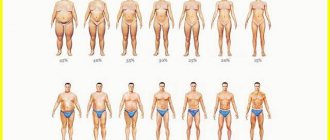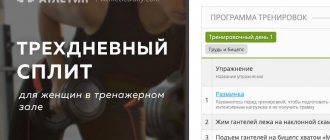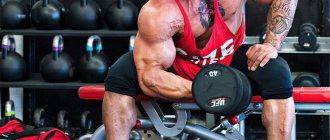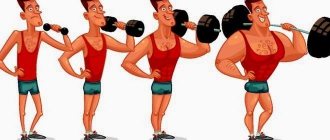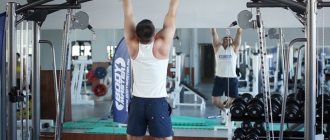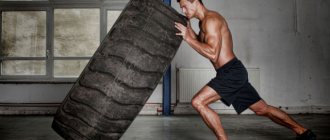Have you been looking for the best bodyweight exercises for weight loss? You've come to the right place.
Whether you're new to fitness or an experienced athlete, the right set of bodyweight workouts will turn you into a fat-burning machine.
In this article, I will share with you my favorite bodyweight exercises for burning fat, for both women and men.
But before we look at exercise, it's important to know two ways you can make sure that weight-free exercise helps you burn fat throughout the day and build your strength.
Method one...
You have to work smart [work = force x distance]
This basic physics formula will help us understand why some weight loss exercises are better for burning fat than others.
In other words, the “work” in this formula means the number of calories burned. “Force” is the amount of effort applied, and “distance” is some segment over which this force is created.
Simply put, more calories will be burned doing burpees than doing push-ups.
Why?
Although push-ups are the best bodyweight exercise, they only lift your body weight from the floor to the point where your arms are fully extended (about 30-60 cm).
Unlike push-ups, during a burpee jump you travel a distance of approximately 210-240 cm. When performing a burpee, more muscles are used, you put more effort into the exercise and cover a greater distance.
As a result, you work out and burn more calories.
Am I still not convinced?
Do 10 push-ups, then rest. Then do 10 burpees and rest. What was more difficult for you?
Of course, burpees!
The more difficult the bodyweight exercise, the more work you do and the more calories (fat) you burn.
While this formula is a direct route to burning extra calories, there are plenty of other bodyweight exercises that can help you shed fat and make you stronger without having to travel long distances...
And here comes the second secret to successful weight loss...
How to Burn More Calories and Get Stronger with Bodyweight Exercises
If you, like me, find it easy to do push-ups, squats, or lunges, or can't even do a single push-up or pull-up, then these two tricks will help solve all your problems:
- Make your workouts more challenging with bodyweight exercises;
- Make it easier to do bodyweight exercises.
It sounds a little strange, of course, I understand. But you'll see what I mean at this point. I will explain point 2 a little later.
Let's say you want to build strength and add a little more complexity to basic, non-weight-bearing exercises like push-ups and squats. Besides adding extra weight (it won't be bodyweight exercises anymore), here's what you can do:
Pause briefly during the eccentric portion of the movement. By a short pause I mean a good period of time, equal to 5-6 seconds.
Eccentric contraction is the active contraction of a muscle during its lengthening.
For example, in push-ups, the eccentric phase of the exercise is the moment when the body lowers to the floor. At this point, you are working against the force of gravity and keeping your body from falling down.
This surprisingly beneficial eccentric phase also causes delayed onset muscle soreness, or soreness, about 48 hours after circuit training.
But don't worry, as this discomfort will not haunt you after every strength training session, only after the first few workouts until your body gets used to it. For example, if you do eccentric training first and then regular training for a week, then you will experience much less muscle pain.
Necessary equipment
For home. I recommend that you purchase a special crossbar that can be installed in the doorway, or make a homemade one that is reliable.
Also, if you have never done pull-ups before, then a rubber expander will be indispensable for you. Prepare two strong chairs or stools at once - they will imitate beams.
To pump up your abs, you would benefit from a gymnastic wheel or, as it is called, a gymnastic roller, and to enlarge your legs, you will need a jump rope. To pump your neck you will need a towel (I think you have one).
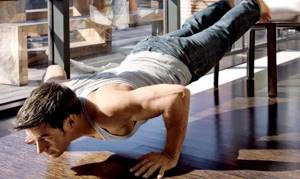
For activities on the sports ground. If you are also a beginner and have never really done pull-ups or push-ups before, then a resistance band will be very useful. Buy a jump rope.
Eccentric training has many benefits for your body, including:
- Increases protection against injury and re-injury.
- You get less tired from training.
- There is the potential to increase resting metabolic rate by 9%, with the highest levels in the first 2 hours.
- Increases strength and performance.
Eccentric training, which focuses on lowering slowly, increases strength and fat burning because the muscles are under more tension than a conventional approach to the exercise.
There is more tension in an eccentric muscle contraction than in a concentric one (read about this below).
Think about it: you will have to put more effort into slowly lowering your body, fighting the forces of gravity. And this is actually what you need, because the more effort you put in, the more muscles you will use and the more calories you will burn!
Now do you understand how it works and how you can squeeze more out of regular exercises with your own body weight and without machines?
Bodyweight training program: safety precautions
If you ignore some rules, you can get injured. “Warming up at the beginning of training, joint exercises, increasing body temperature, heart rate, and correct exercise technique are required. You should gradually complicate the training, building exercises from simple to complex,” says Elena Chindyaeva.
Pay special attention to the technique of doing the exercises. “Control your movements as much as possible. You must clearly understand what you are doing and how. Avoid completely unfamiliar exercises, adds Edward Kazaryan. - Maintain a long, elongated spine. Do lumbar and neck stabilization exercises.”
Here's how it works
- Our body has different types of muscle fibers that do different jobs. For example, slow twitch fibers (type 1) are needed for long, slow activities, while fast twitch fibers (type 2) are needed for short, explosive activities.
- The more force a muscle fiber produces, the less endurance it has (i.e. Type 2). We cannot work with stronger fibers (type 2) without also working with weaker fibers (type 1).
- The stronger the fiber (type 2), the more benefits we get from it, speeding up metabolism and burning fat.
What this all means is that when you force your body to WORK harder, like during the eccentric portion of the movement, you get maximum benefit from all the muscle fibers involved. This means you become more active, speed up your metabolism to burn fat... And develop your strength even more.
It's a win-win!
All the cream on top
If you use your EXPLOSIVE strength during the concentric phase of the contraction (like the upward movement of your body in a push-up), you will be able to recruit more fast-twitch muscles because you will be exerting more force than you would with a normal bodyweight lift.
This means you will become even stronger and burn more calories.
Training for slow eccentric and explosive concentric phases of movement is almost completely ignored by most people, significantly reducing the benefits and quality of bodyweight exercises.
Such training, among other things, has a number of health benefits:
A study out of Boston found that doing exercises that recruit more type 2 muscle fibers also improves insulin sensitivity and lowers blood levels of insulin, glucose, and leptin—all to help you lose weight. All this happens despite a decrease in physical activity.
Big benefit: If you train smart, you won't have to work as hard, which will help you avoid injuries and wasted time in the gym.
Have I convinced you that working out fast-twitch muscle fibers is the key to losing excess fat and developing strength and power in your body?
I sincerely hope so!
Gaining muscle mass when training with your own weight[edit | edit code]
1st Commandment: Complete repetitions![edit | edit code]
Today, training methods involve performing the exercise a small number of times with a large number of approaches and maintaining strength. Why the small number of exercises that preserve strength? Because it allows you to develop a skill. If you want to improve your movements, whether it's a handstand or an alligator, training your nervous system is key. This means performing the exercise correctly many times in order to fix the trajectories of movements in your mind as accurately as possible. The best way to do this is to perform a small number of repetitions of the exercise, not too strenuously or for a long time, so as not to run out of steam and fatigue, and after a short break, do a new set. Then wash, freshen up and repeat. In general, this is how skinny guys with low mass who train with bodyweight develop enormous strength without adding muscle mass.
This is an amazing way to effectively capture the trajectories of movements in the nervous system without getting tired. This approach is ideal for training a skill. What about piles of bulging muscles? Sorry, but the described method is not suitable for this.
Muscle mass does not grow when the nervous system is trained. It grows with muscle training! And for this, guys, you need to do a lot of repetitions. You build muscle mass as chemical energy is produced in muscle cells. Over time, your body responds to this impulse by storing more chemical energy in these cells. But in order to activate this reserve, it is necessary to use up all the chemical energy located in the muscle cells.
This can only be achieved through constant intense training. Gentle training will not achieve this - when performing low-intensity exercise, energy is produced from fatty acids and other sources, and not from valuable muscle cells. With irregular training, a small number of repetitions and approaches, this will also not be achieved, since the chemical energy in the cells is quickly restored during rest, and this means that the reserves are not reduced enough for the body to give a signal.
The best way to use up the energy stored in your muscles is to perform the exercises many times, intensely and continuously. Try to love them. For maximum benefit, gradually increase the number of repetitions of the exercises: first once, then twice, then three. Be sure to start doing 5 times. 6-8 times is great. Twice as much is even better. 12-15 times is a new level of muscle training.
2nd commandment: study intensively![edit | edit code]
This commandment directly follows from the previous one. Doing low reps, maintaining strength, and taking long breaks between sets is a fairly gentle training regimen. However, when performing a large number of repetitions in one set, the training is much more intense. The more approaches, the more intense the workout.
Your muscles will burn and beg you to quit the exercise (this “burning” signals the release of chemical energy reserves needed to perform the exercise - which is exactly what you need!). Your heart will be pounding, you will be shaking, sweating, and feeling constantly stressed. There may even be attacks of nausea.
At the moment, the trend continues in which athletes perform easier approaches, conserve strength and work on skill. Today people don't pump, they practice. “Pump up”, “give it your all” - today in the gym such expressions have become dirty words. They are considered outdated, coming from the 1970-1980s.
You don't want to go overboard with bodyweight exercises—at least in most cases. You want to have some strength left after completing the set so that you can control your movements or defend yourself if necessary. But that doesn't mean you shouldn't work hard. You have to work very hard.
Brutal stress not only will not destroy you physically, but coupled with good rest and sleep, it stimulates the body’s production of testosterone, growth hormone, endorphins and many other pleasant things that Mother Nature has awarded hunters and warriors.
So take up the challenge. Get yourself together, pull yourself together - and move forward, okay? Don't be afraid to expand your pain range if you want to achieve muscle growth. Exercise intensely!
3rd commandment: do simple complex exercises![edit | edit code]
This commandment is directly related to the previous two. If you intend to train intensely, doing moderate to high repetitions of the exercises, these exercises cannot be complex or require special skills. If you have to concentrate on maintaining balance when doing a handstand or crocodile, you can't overdo the exercise—your form will fall apart (along with you) before you can put in enough effort to work the muscles.
So if you decide to do exercises that require specific skills, stick to the concept of doing exercises with low reps, high reps, and maintaining strength. But if you want to get big, you need exercises that don't require significant skill, i.e. "simple exercises" Simple does not mean easy. Doing 20 one-arm pull-ups correctly is simple, but not easy!
Perform the exercises in a way that provides maximum stress to the muscles without expending nervous system energy on factors such as balance, coordination, overcoming gravity, etc. Dynamic exercises, which involve moving the body horizontally or vertically, are usually much more effective than exercises static position because they tend to require less concentration and exhaust muscle cells faster.
The best dynamic exercises are complex exercises that involve multiple muscle groups. Not only are they simpler, the fact is that when they are performed, different muscles of the body work in conjunction, which is more natural, in addition, the need to simultaneously work different muscle groups gives the athlete an additional incentive to apply effort. You should pay attention to the following exercises:
- pull-ups;
- squats, pistol exercises, one-leg squats;
- push ups;
- Australian pull-ups;
- dips;
- bridge stand;
- handstand push-ups (doing the exercise against a wall requires less skill but more effort);
- leg lifts.
All of these movements can be performed with increased difficulty depending on the number of repetitions performed in one approach (see the 5th commandment). And there can be no concessions here.
Focus on simple compound movements and watch your muscles grow at rates never seen before!
4th commandment: limit the number of approaches![edit | edit code]
Here is another rather controversial proposal, and, as usual, it follows from the previous commandments. Why? Well, if you're exhausting your body with heavy loads and concentrating your efforts on performing exercises with high reps in order to maximally load your muscles, why would you need to do extra sets?
Depleting muscle cells to the point where the body feels uncomfortable triggers a survival mechanism that signals the body to produce more energy (leading to muscle growth) for the next time. That's all you need to do. It is enough to trigger this mechanism once and give the body a signal to grow muscles... but what is the point of trying to trigger this mechanism again and again? This is a waste of time and effort, or rather, it is even worse because it destroys the muscles and prolongs the recovery period. To quote the infamous sports theorist Mike Mentzer: “You can take a stick of dynamite and poke a pencil at it all day and it won’t explode. But once you hit it with a hammer, BOOM, it explodes!” One concentrated grueling approach with complex exercises is better than 20-30 gentle approaches.
Those who want to achieve maximum muscle growth should perform one exercise in two powerful sets after a good warm-up. There will be growth after one approach, but to be on the safe side, you can perform two approaches. Beginners should perform more approaches, but not for growth - this will help them work out the movements more clearly. Basically everything comes with practice. Once you have learned how to do the exercise correctly, two intense sets will be enough.
Performing additional sets does not make the workout more intense or effective—quite the opposite. When performing five or six approaches, the following happens: either you make the last approaches weaker than the first, or you work at half strength, making all the approaches weaker than you could otherwise. None of this will ensure muscle growth and will only complicate the recovery process and increase the risk of injury.
Also, do not stretch your workouts. Intense training and long training are not the same thing. In reality, these are two mutually exclusive types. Train briefly, but intensely, and reap the fruits of your labors, comrades.
5th Commandment: Record your progress - keep a training log![edit | edit code]
Believe it or not, there are people who strictly follow the previous four commandments - loading their muscles to the fullest, training intensely, performing the most effective exercises and putting effort into a small number of approaches - and yet do not achieve significant success. This happens even if they train year after year.
What causes this discrepancy? Maybe genes are to blame for everything? Or that they trained without steroids? Or because they weren’t pulling their last strings? Or perhaps because their gym doesn't sell the latest super anabolic, highly toxic, high sugar supplements?
None of what has been said is true. To find out the real reason, read the following excerpt from the Convict Conditioning Ultimate Bodyweight Training Log:
“If it is so easy to succeed in training, why do so few aspiring athletes achieve any decent level of strength or muscle mass or even just good results?
The answer is that few athletes take advantage of the window of opportunity that training affords them. You see, when you exercise, your body adapts to cope with stress, but this adaptation happens extremely slowly; This is especially true for those who have already passed the beginner stage. The successes are insignificant: you can do one more repetition, you can improve your form in some places, and in others you can increase the recovery period. However, over months or years, these small successes finally turn into big successes. This is how seemingly unnatural athletes double or triple their strength by adding inches to their pure muscle size and creating superhumans.
It's sad that because many athletes don't notice these small changes, they don't make the most of them. These small weekly changes are actually windows of opportunity. If you could increase your strength by just 1% per week, you would more than double it in two years. But most athletes don't even come close to doubling their strength because they don't track their training progress. They don't notice that 1% of adaptation is an additional repetition and the form immediately improves. If you miss such small successes, how can you achieve big successes?
In fact, 1% is a very modest goal. When you rely on memory, instinct or feeling, as many athletes often do, the goal becomes blurred. (Not the best thing that can happen to a small goal, is it?) Logging your progress makes the goal clear and obvious. This makes it measurable. Athletes who start making simple journal entries about their workouts suddenly find that they know what they need to do to make progress after each workout. They never lose sight of even a tiny 1% of the result.”
Here is the result. In fact, the previous four commandments are useless unless you practice them all together to make progress - week after week, month after month, year after year. It doesn't matter how insignificant these improvements may seem at first glance. They accumulate for months and years. In short, the secret to building muscle and strength without chemicals is to notice all the smallest gains and replenish them regularly. The best way to do this is to keep a training log. A simple workout journal, if kept correctly, will provide more fitness benefits than all the over-the-counter nutritional supplements on earth.
6th Commandment: Muscles grow while you rest. So relax![edit | edit code]
Again, the rest issue follows closely on the heels of the previous idea of tracking progress.
If you really want to achieve results from the last exercise, what do you do - do an extra rep, tighten up your form - what approach will you choose for this exercise? Would you like to feel tired, tired, overwhelmed? No! This is madness! Obviously, you want to be rested, as cheerful as possible, so that you can diligently and energetically take on a new exercise and break your records, perform each exercise more times, and grow above yourself!
This question may seem stupid. Of course, you would want to be alert and as well rested as possible if you want to give it your all and maximize muscle growth stimulation, right?
In fact, future bodybuilders do exactly the opposite. They've been brainwashed by the muscle magazines and are trying to do the same programs for steroid addicts who puff seven times a day, frantically trying to burn off their mental and hormonal energy by training more and more often. Some of these guys train intensely four times a week... and then wonder why they don't get any results!
You don't have to be Sherlock Holmes to understand why they don't get results. You don’t have to be a candidate of biological sciences in the field of myology to understand why they don’t have results. They're just tired. They didn't give their muscles a chance to rest and recover, or leave them alone to grow in size and strength. Sometimes the reason for this is the very atmosphere of the workout: we are so carried away by the thought of training that we forget that we are literally tearing our muscles at this moment.
We've forgotten one simple old fact about gaining muscle mass—muscle grows through rest, not training.
The amount of rest required to achieve optimal results depends on the athlete's age, body composition, training experience, other activities, etc.
- Working on the same muscle group more than twice a week is not a good idea if you want to gain muscle mass.
- How often you train doesn't matter at all - what matters is how often you make progress.
- Training a muscle group once a week (and actually making progress) is better than training it four times a week and going backwards.
- Never train one muscle intensely two days in a row.
- Old school bodybuilders like Steve Reeves and Reck Park got huge by training intensely just three times a week. Today, many of the most powerful powerlifters train only three days a week. The idea that you need to train every day (or multiple times a day) to maximize your potential is absurd.
- Larger muscles usually require a longer recovery period than smaller muscles.
- If a muscle group hurts, you should stop the exercise immediately!
- Muscle training also leads to depletion of the body's hormonal and heat exchange systems. If you feel depressed, tired or exhausted, add another day or two of rest to your program, even if you feel your muscles are fine.
- Always take at least two days a week of complete rest for maximum muscle growth unless you are doing low frequency exercise. Even then, three to four days of rest per week may still be necessary.
- The end point of a bodybuilding program is progress in muscle growth and performance. If you're working out intensely but can't increase the number of repetitions per exercise you perform, take an extra rest day.
The maximum task: to ensure muscle growth, you need to continue to improve your performance, concentrating a large load in a small number of approaches. For this to happen, the muscles (and the body) must rest. Rest is a much more important element of training than many athletes realize—and as a result, they don't come close to reaching their full potential.
7th Commandment: Stop eating “healthy” food all the time![edit | edit code]
It is enough to read excerpts from magazines dedicated to bodybuilding or fitness, gathering dust on news stands, and one gets the impression that the ideal diet for muscles is chicken breast with broccoli, and do not forget about biological supplements. Rinse all this well in water.
If you want to gain muscle mass, then periodically eating fast food is not only normal, but even healthy - it is a good anabolic steroid.
One of the biggest sensations in modern bodybuilding was the guy who these days is known as Kali Muscle. Kali's height is 178 cm, and her weight is more than 113 kg including abs. Cali found his art in San Quentin prison surrounded by bodyweight gymnastics athletes, and despite being so heavy, he still performs impressive bodyweight feats like power-ups and the flag. Kali says he started gaining weight when he was in prison and began filling his belly with “dirty” high-carbohydrate fast food, such as donuts, honey buns, ramen, and tuna pate. He says the effect high-calorie fast food had on his skinny body was so dramatic that he stopped taking steroids while in prison. He didn't need them.
Kali is not crazy. There is truth in his words. The idea that you need fast food to workout is not new. Many old school strongmen ate mountains of food that today is considered garbage. The Saxon brothers' daily diet necessarily included cakes and beer. John Grimek often drove around with huge Hershey bars in his glove compartment, which he took with him just in case.
And don't forget to eat some fat. Stop skipping real muscle foods: red meat, egg yolks, ham, cheese and sausage. Manufacturers (as well as their henchmen - fitness magazines) will never mention a reliable fact known to every endocrinologist on earth - testosterone is produced from cholesterol. That's right: without consuming enough cholesterol from fatty foods, the body cannot produce testosterone and muscles cannot grow.
Vegans often complain that meat is full of pathogens and other crap, but not only does consuming it not kill us—recent research has shown that red meat may be the reason our species lives so uncharacteristically long. Our hungry ancestors literally adapted to pieces of meat, which contributed to the development of superimmunity in them.
If you are trying to build muscle mass, your meals should be balanced and regular. But eating only “healthy” foods can have a negative impact on your results. Eat fast food every day if you want to grow. Eat a burger or cookies and cream and in a couple of hours you will have the best workout of your life. You may even gain muscle mass.
8th Commandment: Get enough sleep![edit | edit code]
Is there a natural replacement for steroids? There is, but they don’t sell it in the pharmacy. This is called sleep. During sleep, the brain instructs the body to produce its own performance-enhancing substances.
Actually, this is how our ancestors lived - when the sun went down (the lights turned off), the brain and nervous system turned off for a well-deserved reboot. People can control artificial lighting using light bulbs, LCD TVs, laptops and mobile phones. They can go for a walk, or have a drink, or go to a party, or, if desired, watch TV series all night. As a result, the sleep patterns of many, especially young people, are disrupted. And they still wonder why they have insomnia or problems sleeping... There is no daily routine as such, and people definitely don’t get enough sleep - on average, a modern American sleeps about seven hours a day, or even less.
Many authors of exercise books combine rest and sleep in one chapter. It is not right. Sleep is a unique physiological state. Ten minutes of sleep is not the same as 10 minutes of rest... or even 20 minutes of rest... or even an hour of rest. During sleep, the same thing happens to the body and brain as during rest, but not the other way around.
- The brain produces growth hormone - a dangerous, expensive and illegal dope if you buy it on the street, but useful and free if you go to bed.
- The brain produces natural melatonin, perhaps the most powerful immune booster known to science. (In addition to helping muscles recover, melatonin can also prevent the formation of cancer cells. This substance has magical properties!)
- When you sleep, the brain releases luteinizing hormone, which (in guys) significantly stimulates the interstitial cells to produce testosterone, the No. 1 chemical stimulant for muscle growth.
And this is only a small part of how sleep benefits a bodybuilder. Sleep is the foundation of muscle growth, and if that's not a compelling argument for you to try to get a good night's sleep (napping will do, too), what do you say: extra sleep can make your body ripped.
Your sleep and wake patterns can even determine your eating patterns. When our species was in the early stages of evolution, the annual period of fertility fell at the end of summer - a time when daylight hours were still quite long. At this time, our ancestors frantically tried to find any fruit rich in carbohydrates in order to gain reserves of subcutaneous fat for protection against the brutal, hungry winter period that was already approaching.
Nowadays, almost everyone artificially extends their daylight hours to completely useless limits with the help of bright lighting in their homes, not to mention flickering zombies, computer games, etc. As a result, the part of the brain that evolved in the Paleolithic era still thinks that she is stuck at the end of summer, which lasts all year round. And the brain reacts accordingly, constantly releasing neurotransmitters and hormones programmed to greedily consume any carbohydrates it can find. No wonder these guys can't stick to a specific diet. The brain tells them to eat as much as possible to survive the winter!
Go to bed early so your internal calendar will never be confused, your brain won't feel like it's fertile time, and you'll find that you don't want to gobble up every available carbohydrate. It works.
Sleep also causes fat cells to produce leptin, sometimes called the muscle hormone. Leptin regulates the consumption of fat mass and triggers the mechanism for releasing energy from adipose tissue. Go to bed before reading the next commandment, guys. You might already have abs when you wake up.
9th commandment: train not only the body, but also the mind![edit | edit code]
This is an axiom. The role of consciousness in training is so fundamental that many books do not even mention this factor. Classic bodybuilders, of course, understood this, but not deeply enough. Vince Gironda, an iron guru and true trainer to champions including Mr. Olympia Larry Scott, was once asked what he thought was the most effective supplement. Here's what he said: “No supplement company has yet come out with a pill or powder that can match the potency of consciousness. On the contrary, the power of consciousness can equal or even surpass the effectiveness of any nutritional supplement... if you demand it of your consciousness. These dumbbells didn't do me any good. They never whispered in my ear, “Take me. Raise me four times, do it for so many weeks.” I dominate the dumbbells. I have control over my own body, okay? Do you need any more comments? (Scott L. Wild form // Mus-clemag. Issue 132).
Isaac Newton taught us that an arrow flies in a straight path for an unlimited distance until external forces (friction, gravity, etc.) bring it to rest. Human consciousness works in a similar way. It moves in a straight path until a negative impact nails it to the ground. This negative impact is caused by destructive ideas and a negative way of thinking. When it comes to bodyweight training, there are six classes of ideas that ruin our workouts or cause us to quit altogether.
10th commandment: pump up your strength![edit | edit code]
The content of this section can be briefly summarized in one sentence: strength increases faster when training the nervous system, mass is gained faster when muscles are pumped.
The connection between the nervous and muscular systems is vaguely reminiscent of the connection between an electrical circuit (nervous system) and a light bulb (muscles). As the power increases, the light bulb burns brighter. Likewise, greater stimulation of the nervous system (through neuromotor unit firing and relaxation) causes your muscles to contract more intensely, making you stronger.
A bodybuilder primarily trains his muscles - he constantly buys more and more powerful light bulbs. A strength athlete trains his nervous system first - he simply increases the voltage supplied to a smaller light bulb. And just as you can have very powerful light bulbs, but very small in size, so in sports there are super-strong athletes with a relatively small amount of muscle.
Here's the thing: to some extent, both of these athletes want the same thing - more "light", which in our analogy means the result of muscle work. Athletes who really want to reach the limit of strength also train their muscles - they buy larger bulbs. This is observed in powerlifting, weightlifting and other strength sports. As athletes develop strength, their mass increases, allowing them to
Light bulb analogy: Think of the light bulb as your muscle mass and the power supplied as stimulating your nervous system to compete in different weight classes. A strong, big athlete is always stronger than a strong, but small athlete.
But bodybuilders also want more “light” (more muscle efficiency) because it allows them to perform heavier exercises and lift heavier weights, stimulate their muscles more to adapt more effectively, which leads to greater results in gaining mass. Everyone understands that the larger a bodybuilder becomes, the more weight he has to work with in order to maintain the achieved results and move towards further progress.
In other words, if you want to gain as much muscle mass as your genetic potential allows, simply training your muscles will not be enough. It is also necessary to train the nervous system—at least part of the time.
Have you ever noticed how guys who just started bodybuilding make a lot of progress and get in shape in 3-6 months, and then it stops? They are literally running out of energy. How intensely you can train your muscles and how much stress they can withstand depends partly on your strength. If these beginners spent 3-6 months training the nervous system instead of the muscles and building exclusively strength, they would later find that they were quite capable of returning to bodybuilding training and would experience a new round of muscle growth.
All classic bodybuilders understood the connection between size and strength. Many of them devoted 3-6 months of the year exclusively to training the nervous system in order to pump up maximum strength, and did not particularly worry about muscle size at this point. Others combined pure strength exercises with bodybuilding and either performed them in different workouts or alternated them in the same workout. Today, successful bodybuilders do the same thing - they combine muscle building work with strength training. They understand that one without the other will not be effective enough.
What's the key point here? It's simple. Muscle training allows you to build mass, but without additional strength it is impossible to maintain positive results. You will achieve better results if you alternate (or combine) strength training, which focuses on the nervous system, with training designed to gain mass.
The next question is: how should you train your nervous system to develop strength using bodyweight techniques?
Author: Paul Wade
What if you're new to fitness?
As I've said before, slow eccentric movements can make difficult exercises without weights easier.
Let me show you what I mean:
Let's say you can't do a full push-up. However, there are several other push-up variations that you can master. Start in a plank position and slowly lower yourself toward the floor. Rest a little, focus on your knees and return to the plank position.
Of course, this is not a full push-up, but by focusing on the negative part of the movement, you can build stronger muscle fibers that will later help you perform a full push-up.
From a physiological point of view, it looks something like this: we are 120% stronger eccentrically than concentrically. Which means we find it easier to lower the weight than to lift/push it.
The same applies to pull-ups.
If you have problems with pull-ups, don't beat yourself up right away. Instead, stand on a chair, jump up above the bar, and SLOWLY lower yourself down until your arms are fully extended. And repeat again.
This is a smart approach to improving your strength! And also a way to make a difficult bodyweight exercise easier.
Now that we've got the basics out of the way, let's move on to...
What equipment will you need?
Circuit training is not a specific type of load, it is an approach to building a program. You can perform it with any equipment and in its absence. However, even if you study at home, having the following items will be a big plus:
- gymnastic mat;
- chair or sofa;
- sports equipment (dumbbells, kettlebell or baseball).
Performing the same exercise with and without weights gives different results. The presence of sports equipment allows you to increase the load on the muscles, which, in turn, “draws” them.
Conclusion: sports equipment and special clothing are not prerequisites for starting training. However, with them the level of psychological comfort increases, motivation increases and better results are achieved.
Best exercises
Circular training with your own weight for girls should consist of exercises for different muscle groups. Before you start training, you need to do a 5-10 minute warm-up. Swinging your arms, tilting your body and head, twisting your torso, and taking long steps will help prepare your muscles for stress and reduce the likelihood of injury.
For the neck
Stand up straight, place your palm on your temple so that your fingers point towards the back of your head. Lightly press your temple with your hand and, overcoming the resistance, turn your head. Repeat 10-15 times in each direction.
For shoulders
Push-ups give a good load on the muscles of the shoulder girdle. If the classic push-up is too difficult to do, you can start with knee push-ups.
Technique:
- take a lying position, bend your knees, cross your ankles;
- slowly raise and lower your body, bending your elbows.
For hands
Arm rotations:
- stand up straight and spread your arms to the sides;
- perform 10-15 rotations with your arms forward, then the same number - back.
For the back
Exercise "Superman":
- lie face down so that your chin touches the floor;
- stretch your toes so that they touch the floor;
- extend your arms forward, placing your palms on the floor;
- raise your arms and legs to the same height;
- hold the position for 10-20 seconds.
For the buttocks
Plie squats help pump up the inner thighs and buttocks. Technique:
- place your feet wider than your shoulders;
- turn your socks 120 degrees;
- squat down so that your thighs are parallel to the floor;
- keep your back straight, do not round your shoulders;
- tighten your abs to support your back;
- When lifting up, additionally strain your gluteal muscles.


